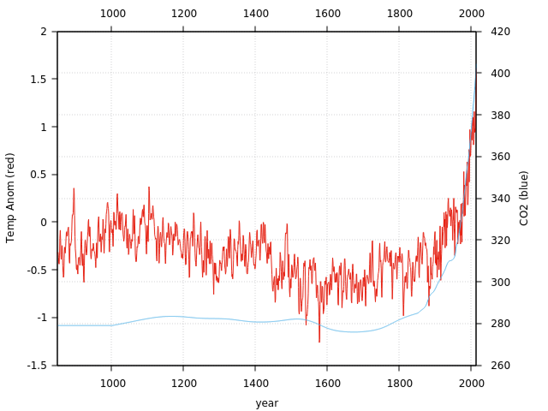Earth Sounds
© Philippe Tortell, CC BY 4.0 https://doi.org/10.11647/OBP.0193.02
Ice Core Walk is a musical representation of environmental climate data taken from the 3 km-long Vostok ice core in East Antarctica. The audio clip below represents a snapshot of atmospheric temperature and CO2 data, from 850 AD to 2016, translated into musical form. This clip is taken from the last five minutes of a half-hour-long audio tour, which allows listeners to experience 800,000 years of climate history as they walk the full 3 km-length of the Vostok ice core. The most recent temperature data are obtained from tree ring measurements, sediments and other sources, while the CO2 data are from a combination of the National Center for Atmospheric Research (NCAR) Community Climate System Model simulations and direct observations. The sounds are synthesized from a physical model of a plucked nylon string guitar — indicating temperature — and a vocal-like synthesis — indicating CO2 levels. This composition articulates the pace of climate change sonically rather than visually, offering listeners a stark audio-perspective on the impacts of humans on the climate system over the past century. Ice Core Walk is a collaboration between scientists and artists from the University of British Columbia (UBC), Stanford University and the University of California, Berkeley. The project was initiated by Philippe Tortell,1 Chris Chafe2 and Greg Niemeyer3 and was supported by the Peter Wall Institute for Advanced Studies, UBC. More information about Ice Core Walk can be found at http://icecorewalk.org/, along with the full half-hour-long audio tour.

Temperature and CO2 data in the ending section (850 AD–2016) of Ice Core Walk. CC BY-NC-SA 3.0 US. See web site for data sources, https://purl.stanford.edu/mg458wc3389

|
Ice Core Walk |

|
Earth Symphony is a musical representation of our planet’s trajectory over the past fifty years, drawn from a range of Earth System data sets — from atmospheric CO2 concentrations and global fisheries catches, to deforestation and the size of the Antarctic ozone hole. These data sets have been translated into a musical score, using a process of sonification that seeks to express and more deeply understand the complex biophysical changes unfolding across the Earth System. The piece is an interdisciplinary collaboration between students and scholars: Philippe Tortell compiled these data from public sources with the help of Environmental Sciences undergraduate students at UBC, and Chris Chafe ‘sonified’ the data into a musical score by creating a process in which music is performed directly by the data. His choices as composer included the speed at which the data are heard, the instruments that play the sounds, and the influence of the data on musical dimensions like pitch and loudness. In recognition of the fiftieth anniversary of Earth Day in 2020, Earth Symphony will be performed by the UBC Orchestra, conducted by Jonathan Girard.4 A video recording of this performance will be available at planetearth2020.org

|
Earth Symphony |

|
Endnotes
1. Professor of Oceanography at UBC, and editor of this volume.
2. Director of Stanford University’s Center for Computer Research in Music and Acoustics.
3. Director of Orchestras at the UBC School of Music.
4. Professor of New Media in Art Practice at the Univeristy of California, Berkeley.
